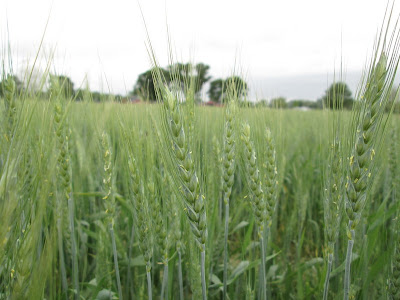So I showed quite a few of the research activities at the NCRS and elsewhere last week. But by no means was that everything. I showed some of the research on winter wheat that we are conducting where we are combining fertilizers and fungicides. The wheat on Farm 8 was at the flowering stage, or anthesis, last Tuesday, so we made some more applications with a different fungicide. Phil is at the wheel here in these large replicated plots on Farm 8. Each "plot" is around 2.5 acres.
Some people may be surprised that wheat flowers. The yellow anthers are visible on the spikelets below, in a nice picture taken by Stephanie. The anthers produce pollen that land on the top of the flower called a stigma, and makes a pollen tube that grows down to fertilize the embryo which gives rise to the grain. Flowering starts in the middle of the head, continues up to the top and then the bottom. So when you see anthers at the bottom of the head, you know that fertilization of the head is nearly complete.
The wheat runs right up to the new apple orchard.
At the same time as the wheat was being sprayed, there was activity within the orchard. Below we see Dan and intern Kirk, himself from a family apple orchard, doing an important operation on the new trees. They are "feathering" them. I am an apple novice, and Dan says it's important to maintain the dominance of the top stem. Otherwise, the tree won't be nice and straight. So you need to pull off any lower young developing stems just below the top that are longer than the one at the top. With over 3000 trees in the orchard, this takes some time. But they made quick work of it.
Below is a properly "feathered" tree that will grow straight. This is nice information even for home use. Dan's orchard knowledge will certainly be useful here.
Remember I showed them putting together this irrigation pipe earlier. Now they have the drip tape attached. By the end of the week this was buried and the tape was connected to the drip tape running at the base of the trees. They gave it a tryout on Friday and I understand it worked. Sadly, I wasn't there for that.
Another operation of the week was the sidedress application of nitrogen solutions to the corn research plots. There are hundreds of plots in different experiments all over the NCRS, and Tim and Stephanie knocked them out in just a few days.
I know everyone talks about it, and everyone is probably tired of listening to it. But this weather is so different from year to year. Last year we didn't turn on irrigation until July. We rarely run irrigation in May, but we have been plenty dry since the downpour several weeks ago. So the overhead linear irrigation systems were started up for an initial run. Below we see the one on Farm 3.
And here is the one on Farm 5. This ground was planted the previous week for the fertilizer demonstrations at the Research Field Days in August and September.
The rest of the farms will have to wait for rain from the sky. Below is Farm 6 which tends to be very subject to drought due to the coarse textured soil. Right now it looks nice here with the 30 inch soyean rows fitting perfectly down the middle between last year's corn rows, just as they should.
Well here on Memorial Day Monday, the farm is closed until tomorrow. But hopefully you are now up to date.









